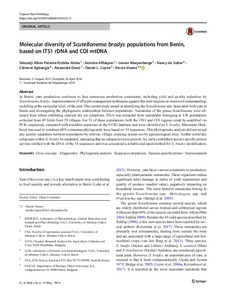| dc.contributor.author | Afoha, S.A.P.E. |
| dc.contributor.author | Affokpon, A. |
| dc.contributor.author | Waeyenberge, L. |
| dc.contributor.author | Sutter, N. de |
| dc.contributor.author | Agbangla, C. |
| dc.contributor.author | Dansi, A. |
| dc.contributor.author | Coyne, D.L. |
| dc.contributor.author | Viaene, N. |
| dc.date.accessioned | 2019-12-04T11:21:01Z |
| dc.date.available | 2019-12-04T11:21:01Z |
| dc.date.issued | 2018 |
| dc.identifier.citation | Afoha, S.A.P.E., Affokpon, A., Waeyenberge, L., de Sutter, N., Agbangla, C., Dansi, A., ... & Viaene, N. (2018). Molecular diversity of Scutellonema bradys populations from Benin, based on ITS1 rDNA and COI mtDNA. Tropical Plant Pathology, 1-10. |
| dc.identifier.issn | 1983-2052 |
| dc.identifier.uri | https://hdl.handle.net/20.500.12478/3637 |
| dc.description | Published online: 10 May 2018 |
| dc.description.abstract | In Benin, yam production continues to face numerous production constraints, including yield and quality reduction by Scutellonema bradys. Implementation of efficient management techniques against this pest requires an improved understanding, including at the molecular level, of the pest. The current study aimed at identifying the Scutellonema spp. associated with yam in Benin and investigating the phylogenetic relationships between populations. Nematodes of the genus Scutellonema were obtained from tubers exhibiting external dry rot symptoms. DNA was extracted from nematodes belonging to 138 populations collected from 49 fields from 29 villages. For 51 of these populations, both the ITS1 and COI regions could be amplified via PCR, sequenced, compared with available sequences in the NCBI database and were identified as S. bradys. Maximum likelihood was used to construct 60% consensus phylogenetic trees based on 51 sequences. This phylogenetic analysis did not reveal any genetic separation between populations by cultivar, village, cropping system nor by agroecological zone. Neither could any subgroups within S. bradys be separated, indicating that no subspecies were present. An earlier published species-specific primer set was verified with the DNA of the 51 sequences and was considered a reliable and rapid method for S. bradys identification. |
| dc.format.extent | 1-10 |
| dc.language.iso | en |
| dc.subject | Dioscorea |
| dc.subject | Diagnostics |
| dc.subject | Yams |
| dc.subject | Nematodes |
| dc.subject | Production |
| dc.subject | Scutellonema Bradys |
| dc.title | Molecular diversity of Scutellonema bradys populations from Benin, based on ITS1 rDNA and COI mtDNA |
| dc.type | Journal Article |
| dc.description.version | Peer Review |
| cg.contributor.crp | Roots, Tubers and Bananas |
| cg.contributor.affiliation | Université d'Abomey Calavi |
| cg.contributor.affiliation | Flanders Research Institute for Agriculture, Fisheries and Food, Belgium |
| cg.contributor.affiliation | International Institute of Tropical Agriculture |
| cg.contributor.affiliation | Ghent University |
| cg.coverage.region | Africa |
| cg.coverage.region | West Africa |
| cg.coverage.country | Benin |
| cg.creator.identifier | Daniel Coyne: 0000-0002-2030-6328 |
| cg.isijournal | ISI Journal |
| cg.authorship.types | CGIAR and developing country institute |
| cg.iitasubject | Plant Production |
| cg.iitasubject | Yam |
| cg.journal | Tropical Plant Pathology |
| cg.howpublished | Formally Published |
| cg.accessibilitystatus | Limited Access |
| local.dspaceid | 95716 |
| cg.targetaudience | Scientists |
| cg.identifier.doi | http://dx.doi.org/10.1007/s40858-018-0221-5 |

